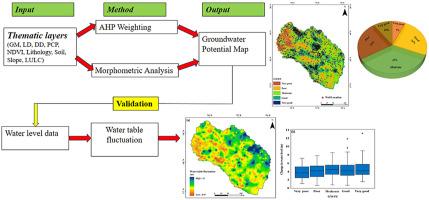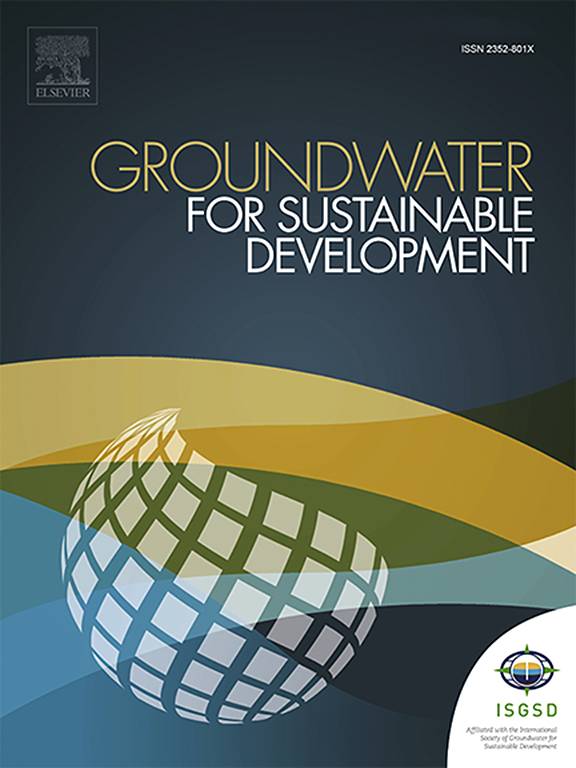Multicriteria decision making for sustainable groundwater development and management in basaltic terrain of Upper Bhima basin, Maharashtra, India
IF 4.9
Q2 ENGINEERING, ENVIRONMENTAL
引用次数: 0
Abstract
Climate change has exacerbated freshwater challenges, leading to groundwater depletion and threatening food security. As demand increases amid shrinking supplies, advanced technologies and methodologies are essential for sustainable groundwater management. This study employed a multi-criteria decision-making approach by coupling the Analytic Hierarchy Process (AHP) with nine thematic layers and 36 morphometric parameters to identify groundwater potential zones (GWPZ) and manage water resources in the Upper Bhima Basin, predominantly characterized by basaltic aquifer systems. Using AHP, five zones were delineated within the basin and categorized as very poor (6.7 %), poor (24.6 %), moderate (34.9 %), good (23.9 %), and very good (9.9 %). The thematic layers' weights demonstrated a high level of reliability, with a consistency index of 0.00051 and a consistency ratio of 0.00035. GWPZ was also validated with the Area Under the Curve (AUC = 0.707). Morphometric analysis further supports the identification of low potential zones in the steep slope region. The mean bifurcation and circularity ratios for the basin, highlighting minimal geological influence on the drainage pattern and varying infiltration capacities. Furthermore, the hypsometric analysis reveals a concave shape with an integral value of 0.19, indicating the potential for developing stable recharge zones for sustainable groundwater management. Besides this, evapotranspiration and NDVI have shown strong seasonality, highlighting the agricultural response of the region and exhibiting a strong connection with ENSO events. Increasing urbanization and agrarian expansion drive water demand, necessitating effective regional groundwater management. Measures like check dams, rainwater harvesting, and cultivating less water-intensive crops can enhance water security.

印度马哈拉施特拉邦上Bhima盆地玄武岩地形地下水可持续开发与管理的多准则决策
气候变化加剧了淡水挑战,导致地下水枯竭,威胁粮食安全。由于需求增加而供应减少,先进的技术和方法对于可持续的地下水管理至关重要。在以玄武岩含水层系统为主要特征的上北马盆地,采用层次分析法(AHP)和9个主题层、36个形态参数相结合的多准则决策方法进行地下水潜力带(GWPZ)识别和水资源管理。利用层次分析法在盆地内划分了5个带,分别为极差(6.7%)、差(24.6%)、中等(34.9%)、好(23.9%)和极好(9.9%)。各主题层权重具有较高的信度,一致性指数为0.00051,一致性比为0.00035。用曲线下面积(AUC = 0.707)验证了GWPZ。形态计量学分析进一步支持了陡坡区低电位带的识别。流域的平均分岔率和圆度比,突出了地质对排水模式和不同入渗能力的最小影响。此外,假设分析显示一个凹的形状,其积分值为0.19,表明发展稳定的地下水补给区具有可持续管理的潜力。此外,蒸散发和NDVI表现出强烈的季节性,突出了该地区的农业响应,并与ENSO事件表现出强烈的联系。城市化和农业扩张推动了用水需求,需要有效的区域地下水管理。诸如拦河坝、雨水收集和种植用水量较低的作物等措施可以加强水安全。
本文章由计算机程序翻译,如有差异,请以英文原文为准。
求助全文
约1分钟内获得全文
求助全文
来源期刊

Groundwater for Sustainable Development
Social Sciences-Geography, Planning and Development
CiteScore
11.50
自引率
10.20%
发文量
152
期刊介绍:
Groundwater for Sustainable Development is directed to different stakeholders and professionals, including government and non-governmental organizations, international funding agencies, universities, public water institutions, public health and other public/private sector professionals, and other relevant institutions. It is aimed at professionals, academics and students in the fields of disciplines such as: groundwater and its connection to surface hydrology and environment, soil sciences, engineering, ecology, microbiology, atmospheric sciences, analytical chemistry, hydro-engineering, water technology, environmental ethics, economics, public health, policy, as well as social sciences, legal disciplines, or any other area connected with water issues. The objectives of this journal are to facilitate: • The improvement of effective and sustainable management of water resources across the globe. • The improvement of human access to groundwater resources in adequate quantity and good quality. • The meeting of the increasing demand for drinking and irrigation water needed for food security to contribute to a social and economically sound human development. • The creation of a global inter- and multidisciplinary platform and forum to improve our understanding of groundwater resources and to advocate their effective and sustainable management and protection against contamination. • Interdisciplinary information exchange and to stimulate scientific research in the fields of groundwater related sciences and social and health sciences required to achieve the United Nations Millennium Development Goals for sustainable development.
 求助内容:
求助内容: 应助结果提醒方式:
应助结果提醒方式:


